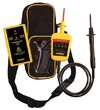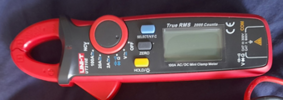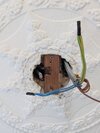The official way is with a tester like this

it comes as two parts, the tester which has no selector switch or battery, so can't be on wrong range or have a discharged or poor battery connection, and a proving unit which will test that it will work with 50 volts and 400 volts, 50 volts being the point when we call it extra low voltage so considered safe, and 400 volts being when the last light on the tester will light.
You would also need to compare with a known earth source, lucky you have that.
However, that is a lot of messing around, so I would be satisfied with the non-contact tester, like this

for example, it has a sensor in the jaws, and will show a voltage without contact in 4 stages between your hand and the jaws tip. These
do the same but single stage, and not as robust, and at the price of £23 against £35 I would pay the extra to have all the other features, however my meter can be turned to the wrong range, and both require batteries so can't officially be used to prove dead.
I find the non-contact voltage is handy to see on a power failure if the DNO fuse has ruptured, as it allows testing without drawing the fuse and breaking the seal, however one has to consider can one ever "PROVE" dead, as so easy for a switch, or some automated unit like a PIR to be off when testing, but turn on later. Including a total supply failure when testing.
Even with the proving unit, I have been supplied with versions which only test at 400 volts, which is a bit useless, as it is not proving the tester will work with 50 volts, above which it is considered dangerous. And the non-contact testers only work will AC, however unlikely to find dangerous DC voltages in the home.
So in real terms it is more down to a risk assessment, I would say one unlikely that wire is still connected, and once covered with another ceiling rose or something else similar, the child is not going to be able to gain access, and with RCD protection as well the risk is very low, clearly not zero, it can never be zero.
But if you are worried, get an electrician, but as said personally if my non-contact tester did not show bars and buzz, I would not be worried.




